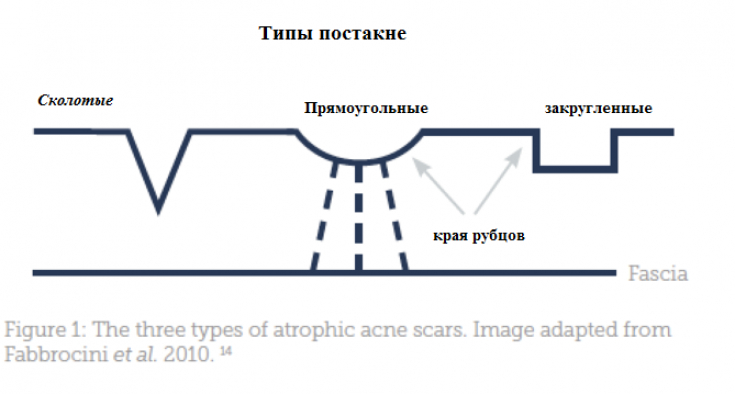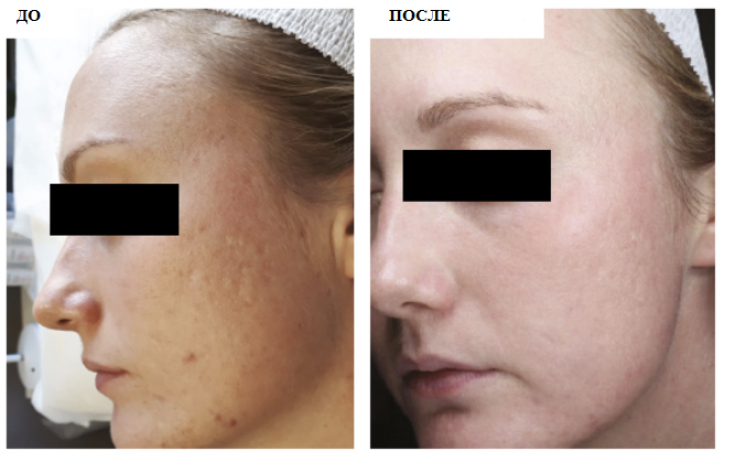Acne ranks eighth in the top ten most common diseases in the world. The appearance of post-acne scars to one degree or another is observed in 95% of patients who have encountered this disease. Topical steroids, laser therapy, and surgical removal are most commonly used to treat post-acne.
But, unfortunately, despite the magnitude of the problem, there is no single effective method for eliminating post-acne scars today.
In this article, Dr. Duncan Brennand discusses an effective technique for combining mesotherapy with platelet-rich plasma (PRP) to reduce the appearance of acne scars.
Classification of post-acne scars: main types of post-acne
There are three main categories of post-acne:
1. Atrophic scars.
2. Hypertrophic scars.
3. Keloid scars.
Atrophic scars most often (up to 90% of cases) appear on the face. Hypertrophic and keloid scars are localized mainly on the shoulders and back.
Atrophic scars, in turn, are divided into three groups:
• - chipped (ice-pick scars): deep narrow v-shaped scars, the depth of which can reach the subcutaneous layer (60 & ndash; 70% of post-acne are represented by chipped scars);
• rectangular (box car scars): wide u-shaped scars with sharp edges, the depth of which is 0.1 & ndash; 0.5 mm (about 20 & ndash; 30% of post-acne – rectangular scars).
• rolling scars: undulating scars greater than 4mm wide (rounded scars account for approximately 15–25% of post-acne).
It is worth noting that in some cases it is difficult to differentiate between atrophic scars and most patients often present with different types of scars.
Post-Acne Therapy: Choice of treatments depending on the type of acne scars 
Fig. 1: Types of atrophic acne scars
It is atrophic scars, in particular rectangular and rounded ones, that are best treated with mesotherapy and PRP, however, a certain degree of improvement is observed when exposed to all types of scars.
It is atrophic scars, in particular rectangular and rounded ones, that are best treated with mesotherapy and PRP, however, a certain degree of improvement is observed when exposed to all types of scars.
What determines the effectiveness of mesotherapy and PRP in the treatment of post-acne
Mesotherapy – percutaneous non-ablative collagen-inducing therapy. During the procedure, thousands of microchannels are created on the patient's skin using a mesoscooter or an electronic device, the depth of which reaches the papillary dermis.
Fibroblast activation in response to skin injury, followed by the release of growth factors and cytokines, as well as changes in the electrical potential of the epidermis/dermis, determine the physiological effects of – neocollagenesis and neoangiogenesis. The accumulation of collagen in areas of atrophic scars promotes tissue remodeling and smoothing of the skin.
The concentration of platelets in PRP, which is obtained by centrifuging the patient's own blood, – over 1x106 units/µl.
After the administration of platelet-rich plasma, as platelets become activated, growth factors begin to be released that promote fibroblast activation and new collagen synthesis:
• platelet growth factor;
• transforming growth factor;
• insulin-like growth factor.
Thus, the complementary effect of mesotherapy and PRP is due to the healing mechanisms that are triggered in response to skin injury, and the action of the main growth factors involved in this process.
Facial mesotherapy: what are the side effects and how to avoid them
Mesotherapy and PRP combined application technique for post-acne treatment
The right choice of patients – one of the main conditions for successful therapy. It is mandatory for the author to conduct a clinical assessment and take a picture of the patient prior to the procedure.
The course of procedures consists of at least three sessions, which are carried out with an interval of one month. It may take up to four weeks to see visible results – the patient should also be warned about this.
The best results after applying the described technique can be obtained in the treatment of rectangular and rounded atrophic scars. Mesotherapy and PRP can also be combined with other methods such as subcision and TCA peels.
Medium peels in cosmetologist practice: opportunities, risks and results of application
Performing procedure:
1. For the preparation of PRP, 24 ml (three tubes of 8 ml) of the patient's venous blood is taken in the elbow area. Tools: 22 gauge butterfly needle and vacuum tube. From 24 ml of blood, 3 ml of the drug is obtained.
2. A topical anesthetic (lidocaine 9.6%) is applied to the patient's face for 30 minutes.
3. Then, with the help of a mesoinjector in the "nappage" (multiple superficial injections of small amounts of PRP) 2 ml of platelet-rich plasma is distributed intradermally over the entire face, with particular attention to scarred areas.
4. After that, 1 ml of PRP is mixed with non-cross-linked hyaluronic acid and used during mesotherapy.
Dermarollers and electronic devices for mesotherapy can be used for this procedure. The author uses an electronic device, but notes that there are no studies demonstrating the benefits of using one or another tool.

Fig. 2: The patient before (left) and after (right) three mesotherapy and PRP treatments with the electronic Derma Stamp device, needle length 1.5 mm. Interval between procedures – 4 weeks
The treatment of acne scars with mesotherapy and platelet-rich plasma is well tolerated by patients and is characterized by a minimal recovery period.
Erythema and swelling remain on the treated area for several days after the procedure.
The treatment of acne scars with mesotherapy and platelet-rich plasma is well tolerated by patients and is characterized by a minimal recovery period.
Contraindications:
• active acne;
• taking anticoagulants;
• blood clotting disorders;
• active herpes infection on the lips;
• Tendency to form keloid scars.
Atrophic acne scars – a common and difficult to correct medical problem that is a source of significant psychological discomfort for patients.
The author uses mesotherapy in combination with PRP as a first-line post-acne therapy because it is well tolerated by patients, relatively inexpensive, associated with minimal side effects, provides good results, and can be used together with other treatments.
Adapted from Aesthetics







Add a comment